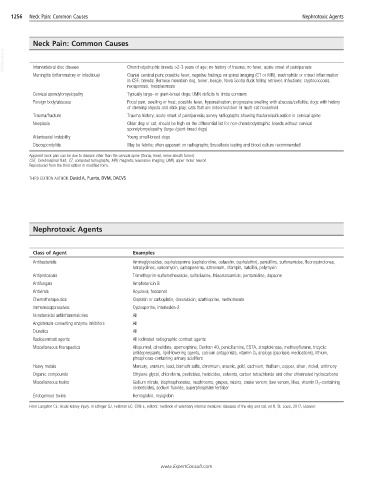Page 2515 - Cote clinical veterinary advisor dogs and cats 4th
P. 2515
1256 Neck Pain: Common Causes Nephrotoxic Agents
Neck Pain: Common Causes
VetBooks.ir Intervertebral disc disease Chondrodystrophic breeds >2-3 years of age; no history of trauma, no fever, acute onset of pain/paresis
Meningitis (inflammatory or infectious) Cranial cervical pain; possible fever, negative findings on spinal imaging (CT or MRI), neutrophilic or mixed inflammation
in CSF; breeds: Bernese mountain dog, boxer, beagle, Nova Scotia duck tolling retriever; infections: cryptococcosis,
neosporosis, toxoplasmosis
Cervical spondylomyelopathy Typically large- or giant-breed dogs; UMN deficits to limbs common
Foreign body/abscess Focal pain, swelling or heat; possible fever, hypersalivation; progressive swelling with abscess/cellulitis; dogs with history
of chewing objects and stick play; cats that are indoor/outdoor or multi-cat household
Trauma/fracture Trauma history; acute onset of pain/paresis; survey radiographs showing fracture/subluxation in cervical spine
Neoplasia Older dog or cat; should be high on the differential list for non-chondrodystrophic breeds without cervical
spondylomyelopathy (large-/giant-breed dogs)
Atlantoaxial instability Young small-breed dogs
Discospondylitis May be febrile; often apparent on radiographs; brucellosis testing and blood culture recommended
Apparent neck pain can be due to disease other than the cervical spine (thorax, head, nerve sheath tumor).
CSF, Cerebrospinal fluid; CT, computed tomography; MRI, magnetic resonance imaging; UMN, upper motor neuron.
Reproduced from the third edition in modified form.
THIRD EDITION AUTHOR: David A. Puerto, DVM, DACVS
Nephrotoxic Agents
Class of Agent Examples
Antibacterials Aminoglycosides, cephalosporins (cephaloridine, cefazolin, cephalothin), penicillins, sulfonamides, fluoroquinolones,
tetracyclines, vancomycin, carbapenems, aztreonam, rifampin, nafcillin, polymyxin
Antiprotozoals Trimethoprim-sulfamethoxazole, sulfadiazine, thiacetarsamide, pentamidine, dapsone
Antifungals Amphotericin B
Antivirals Acyclovir, foscarnet
Chemotherapeutics Cisplatin or carboplatin, doxorubicin, azathioprine, methotrexate
Immunosuppressives Cyclosporine, interleukin-2
Nonsteroidal antiinflammatories All
Angiotensin-converting enzyme inhibitors All
Diuretics All
Radiocontrast agents All iodinated radiographic contrast agents
Miscellaneous therapeutics Allopurinol, cimetidine, apomorphine, Dextran 40, penicillamine, EDTA, streptokinase, methoxyflurane, tricyclic
antidepressants, lipid-lowering agents, calcium antagonists, vitamin D 3 analogs (psoriasis medications), lithium,
phosphorus-containing urinary acidifiers
Heavy metals Mercury, uranium, lead, bismuth salts, chromium, arsenic, gold, cadmium, thallium, copper, silver, nickel, antimony
Organic compounds Ethylene glycol, chloroform, pesticides, herbicides, solvents, carbon tetrachloride and other chlorinated hydrocarbons
Miscellaneous toxins Gallium nitrate, bisphosphonates, mushrooms, grapes, raisins, snake venom, bee venom, lilies, vitamin D 3–containing
rodenticides, sodium fluoride, superphosphate fertilizer
Endogenous toxins Hemoglobin, myoglobin
From Langston CE: Acute kidney injury. In Ettinger SJ, Feldman EC, Côté E, editors: Textbook of veterinary internal medicine: diseases of the dog and cat, ed 8, St. Louis, 2017, Elsevier.
www.ExpertConsult.com

